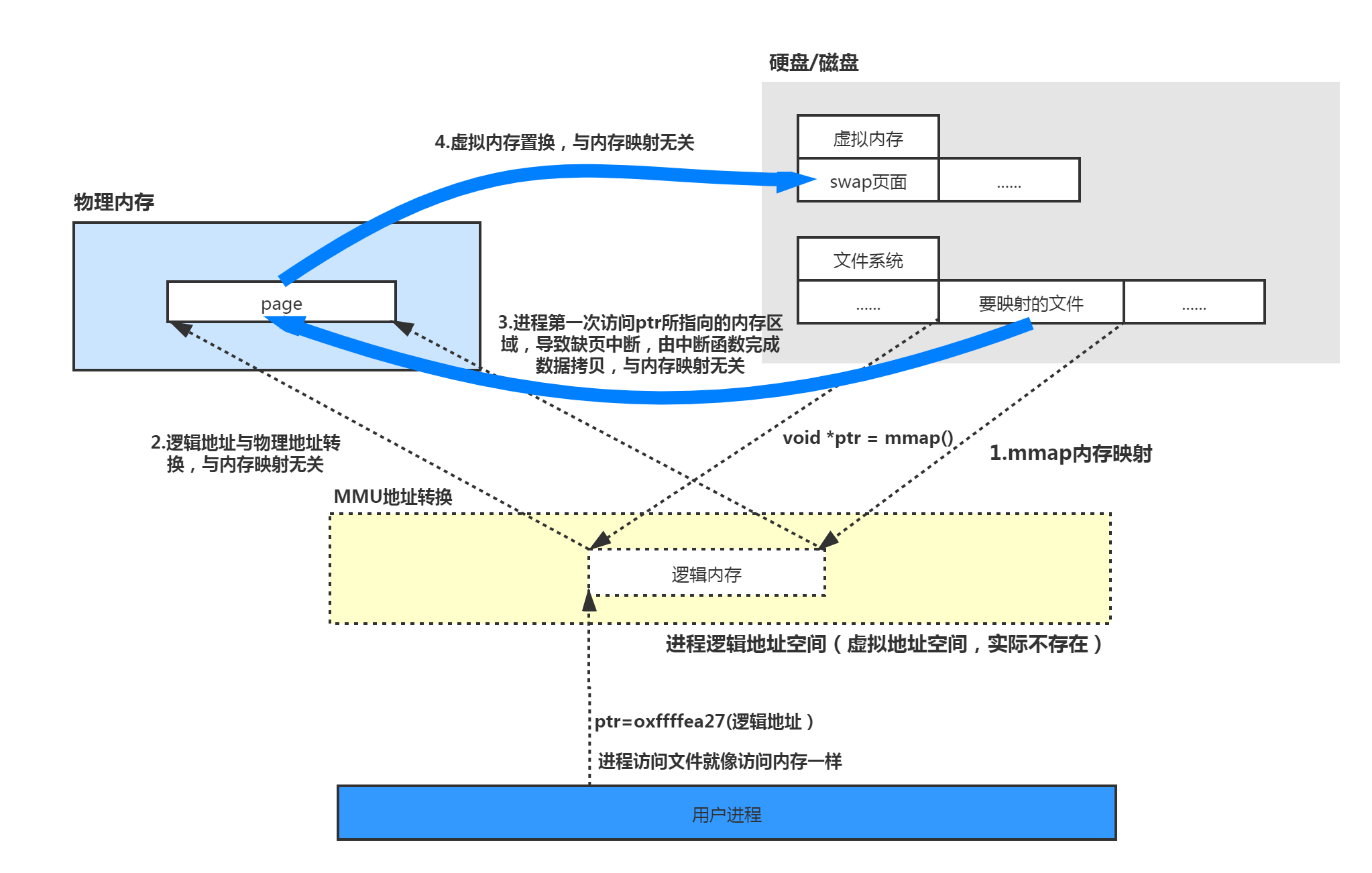RocketMQ中Mmap原理分析及使用
一、Mmap基础概念
Mmap是一种内存映射文件的方法,即将一个文件或者其它对象映射到进程的地址空间,实现文件磁盘地址和进程虚拟地址空间中一段虚拟地址的一一对映关系。实现这样的映射关系后,进程就可以采用指针的方式读写操作这一段内存,而系统会自动回写脏页面到对应的文件磁盘上,即完成了对文件的操作而不必再调用read,write等系统调用函数。相反,内核空间对这段区域的修改也直接反映用户空间,从而可以实现不同进程间的文件共享。
二、Mmap内存映射原理

mmap内存映射的实现过程,总的来说可以分为三个阶段:
(一)进程启动映射过程,并在虚拟地址空间中为映射创建虚拟映射区域
1、进程在用户空间调用库函数mmap,原型:void *mmap(void *start, size_t length, int prot, int flags, int fd, off_t offset);
2、在当前进程的虚拟地址空间中,寻找一段空闲的满足要求的连续的虚拟地址
3、为此虚拟区分配一个vm_area_struct结构,接着对这个结构的各个域进行了初始化
4、将新建的虚拟区结构(vm_area_struct)插入进程的虚拟地址区域链表或树中
(二)调用内核空间的系统调用函数mmap(不同于用户空间函数),实现文件物理地址和进程虚拟地址的一一映射关系
5、为映射分配了新的虚拟地址区域后,通过待映射的文件指针,在文件描述符表中找到对应的文件描述符,通过文件描述符,链接到内核“已打开文件集”中该文件的文件结构体(struct file),每个文件结构体维护着和这个已打开文件相关各项信息。
6、通过该文件的文件结构体,链接到file_operations模块,调用内核函数mmap,其原型为:int mmap(struct file *filp, struct vm_area_struct *vma),不同于用户空间库函数。
7、内核mmap函数通过虚拟文件系统inode模块定位到文件磁盘物理地址。
8、通过remap_pfn_range函数建立页表,即实现了文件地址和虚拟地址区域的映射关系。此时,这片虚拟地址并没有任何数据关联到主存中。
(三)进程发起对这片映射空间的访问,引发缺页异常,实现文件内容到物理内存(主存)的拷贝
注:前两个阶段仅在于创建虚拟区间并完成地址映射,但是并没有将任何文件数据的拷贝至主存。真正的文件读取是当进程发起读或写操作时。
9、进程的读或写操作访问虚拟地址空间这一段映射地址,通过查询页表,发现这一段地址并不在物理页面上。因为目前只建立了地址映射,真正的硬盘数据还没有拷贝到内存中,因此引发缺页异常。
10、缺页异常进行一系列判断,确定无非法操作后,内核发起请求调页过程。
11、调页过程先在交换缓存空间(swap cache)中寻找需要访问的内存页,如果没有则调用nopage函数把所缺的页从磁盘装入到主存中。
12、之后进程即可对这片主存进行读或者写的操作,如果写操作改变了其内容,一定时间后系统会自动回写脏页面到对应磁盘地址,也即完成了写入到文件的过程。
注:修改过的脏页面并不会立即更新回文件中,而是有一段时间的延迟,可以调用msync()来强制同步, 这样所写的内容就能立即保存到文件里了。
三、Mmap方式和常规文件操作区别
常规文件系统操作(调用read/fread等类函数)中,函数的调用过程:
1、进程发起读文件请求。
2、内核通过查找进程文件符表,定位到内核已打开文件集上的文件信息,从而找到此文件的inode。
3、inode在address_space上查找要请求的文件页是否已经缓存在页缓存中。如果存在,则直接返回这片文件页的内容。
4、如果不存在,则通过inode定位到文件磁盘地址,将数据从磁盘复制到页缓存。之后再次发起读页面过程,进而将页缓存中的数据发给用户进程。
总结来说,常规文件操作为了提高读写效率和保护磁盘,使用了页缓存机制。这样造成读文件时需要先将文件页从磁盘拷贝到页缓存中,由于页缓存处在内核空间,不能被用户进程直接寻址,所以还需要将页缓存中数据页再次拷贝到内存对应的用户空间中。这样,通过了两次数据拷贝过程,才能完成进程对文件内容的获取任务。写操作也是一样,待写入的buffer在内核空间不能直接访问,必须要先拷贝至内核空间对应的主存,再写回磁盘中(延迟写回),也是需要两次数据拷贝。
而使用mmap操作文件中,创建新的虚拟内存区域和建立文件磁盘地址和虚拟内存区域映射这两步,没有任何文件拷贝操作。而之后访问数据时发现内存中并无数据而发起的缺页异常过程,可以通过已经建立好的映射关系,只使用一次数据拷贝,就从磁盘中将数据传入内存的用户空间中,供进程使用。
总而言之,常规文件操作需要从磁盘到页缓存再到用户主存的两次数据拷贝。而mmap操控文件,只需要从磁盘到用户主存的一次数据拷贝过程。说白了,mmap的关键点是实现了用户空间和内核空间的数据直接交互而省去了空间不同数据不通的繁琐过程。因此mmap效率更高。
四、Mmap的优点
由上文讨论可知,mmap优点共有一下几点:
1、对文件的读取操作跨过了页缓存,减少了数据的拷贝次数,用内存读写取代I/O读写,提高了文件读取效率。
2、实现了用户空间和内核空间的高效交互方式。两空间的各自修改操作可以直接反映在映射的区域内,从而被对方空间及时捕捉。
3、提供进程间共享内存及相互通信的方式。不管是父子进程还是无亲缘关系的进程,都可以将自身用户空间映射到同一个文件或匿名映射到同一片区域。从而通过各自对映射区域的改动,达到进程间通信和进程间共享的目的。
同时,如果进程A和进程B都映射了区域C,当A第一次读取C时通过缺页从磁盘复制文件页到内存中;但当B再读C的相同页面时,虽然也会产生缺页异常,但是不再需要从磁盘中复制文件过来,而可直接使用已经保存在内存中的文件数据。
4、可用于实现高效的大规模数据传输。内存空间不足,是制约大数据操作的一个方面,解决方案往往是借助硬盘空间协助操作,补充内存的不足。但是进一步会造成大量的文件I/O操作,极大影响效率。这个问题可以通过mmap映射很好的解决。换句话说,但凡是需要用磁盘空间代替内存的时候,mmap都可以发挥其功效。
五、Mmap在java中应用
5.1 Java中Mmap的使用
RandomAccessFile raf = new RandomAccessFile("C:\\Users\\0959\\Desktop\\mmap-test.txt", "rw");
MappedByteBuffer mappedByteBuffer = raf.getChannel().map(FileChannel.MapMode.READ_WRITE, 0, FILE_SIZE);
raf.close();
mappedByteBuffer.put(content.getBytes());
mappedByteBuffer.force();5.2 FileChannel.map()详解
/**
* Maps a region of this channel's file directly into memory.
*
* <p> A region of a file may be mapped into memory in one of three modes:
* </p>
*
* <ul>
*
* <li><p> <i>Read-only:</i> Any attempt to modify the resulting buffer
* will cause a {@link java.nio.ReadOnlyBufferException} to be thrown.
* ({@link MapMode#READ_ONLY MapMode.READ_ONLY}) </p></li>
*
* <li><p> <i>Read/write:</i> Changes made to the resulting buffer will
* eventually be propagated to the file; they may or may not be made
* visible to other programs that have mapped the same file. ({@link
* MapMode#READ_WRITE MapMode.READ_WRITE}) </p></li>
*
* <li><p> <i>Private:</i> Changes made to the resulting buffer will not
* be propagated to the file and will not be visible to other programs
* that have mapped the same file; instead, they will cause private
* copies of the modified portions of the buffer to be created. ({@link
* MapMode#PRIVATE MapMode.PRIVATE}) </p></li>
*
* </ul>
*
* <p> For a read-only mapping, this channel must have been opened for
* reading; for a read/write or private mapping, this channel must have
* been opened for both reading and writing.
*
* <p> The {@link MappedByteBuffer <i>mapped byte buffer</i>}
* returned by this method will have a position of zero and a limit and
* capacity of <tt>size</tt>; its mark will be undefined. The buffer and
* the mapping that it represents will remain valid until the buffer itself
* is garbage-collected.
*
* <p> A mapping, once established, is not dependent upon the file channel
* that was used to create it. Closing the channel, in particular, has no
* effect upon the validity of the mapping.
*
* <p> Many of the details of memory-mapped files are inherently dependent
* upon the underlying operating system and are therefore unspecified. The
* behavior of this method when the requested region is not completely
* contained within this channel's file is unspecified. Whether changes
* made to the content or size of the underlying file, by this program or
* another, are propagated to the buffer is unspecified. The rate at which
* changes to the buffer are propagated to the file is unspecified.
*
* <p> For most operating systems, mapping a file into memory is more
* expensive than reading or writing a few tens of kilobytes of data via
* the usual {@link #read read} and {@link #write write} methods. From the
* standpoint of performance it is generally only worth mapping relatively
* large files into memory. </p>
*
* @param mode
* One of the constants {@link MapMode#READ_ONLY READ_ONLY}, {@link
* MapMode#READ_WRITE READ_WRITE}, or {@link MapMode#PRIVATE
* PRIVATE} defined in the {@link MapMode} class, according to
* whether the file is to be mapped read-only, read/write, or
* privately (copy-on-write), respectively
*
* @param position
* The position within the file at which the mapped region
* is to start; must be non-negative
*
* @param size
* The size of the region to be mapped; must be non-negative and
* no greater than {@link java.lang.Integer#MAX_VALUE}
*
* @return The mapped byte buffer
*
* @throws NonReadableChannelException
* If the <tt>mode</tt> is {@link MapMode#READ_ONLY READ_ONLY} but
* this channel was not opened for reading
*
* @throws NonWritableChannelException
* If the <tt>mode</tt> is {@link MapMode#READ_WRITE READ_WRITE} or
* {@link MapMode#PRIVATE PRIVATE} but this channel was not opened
* for both reading and writing
*
* @throws IllegalArgumentException
* If the preconditions on the parameters do not hold
*
* @throws IOException
* If some other I/O error occurs
*
* @see java.nio.channels.FileChannel.MapMode
* @see java.nio.MappedByteBuffer
*/
public abstract MappedByteBuffer map(MapMode mode,
long position, long size)
throws IOException;(1)将FileChannle对于的文件的一部分直接映射到内存。(这里的内存是堆外内存)
(2)映射模式可以是MapMode.READ_ONLY(只读),MapMode.READ_WRITE(读写),MapMode.PRIVATE(私有,写时复制)
(3)如果是只读模式映射,那么文件通道必须是以只读模式打开。
(4)方法返回的MappedByteBuffer的position是0,limit 和 capacity的值是参数size的值。
(5)一旦映射完成,那么该MappedByteBuffer就和创建它的FileChannel无关。关闭FileChannel不会影响该MappedByteBuffer。
(6)该方法的底层实现依赖于具体操作系统中mmap系统调用的实现逻辑。不同的操作系统可能表现不同。例如:程序修改了MappedByteBuffer的内容,操作系统何时将变更写入到磁盘,这个是不确定的。
(7)对大多数操作系统来说该方法都是一个昂贵的操作,如果仅仅是映射很小范围,那么不建议使用。针对大文件推荐使用该操作。
5.3 MappedByteBuffer详解
MappedByteBuffer本质上是一块堆外内存,也就是DirectByteBuffer。通过FileChannel.map来创建,直到被GC才结束它的生命。
load()方法
加载该缓存的内容到物理内存中。这是因为mapp完成后,OS并没有直接读取文件的内容,当真正要访问的时候,通过缺页异常来进行读磁盘操作。
/**
* Loads this buffer's content into physical memory.
*
* <p> This method makes a best effort to ensure that, when it returns,
* this buffer's content is resident in physical memory. Invoking this
* method may cause some number of page faults and I/O operations to
* occur. </p>
*
* @return This buffer
*/
public final MappedByteBuffer load() {
checkMapped();
if ((address == 0) || (capacity() == 0))
return this;
long offset = mappingOffset();
long length = mappingLength(offset);
load0(mappingAddress(offset), length);
// Read a byte from each page to bring it into memory. A checksum
// is computed as we go along to prevent the compiler from otherwise
// considering the loop as dead code.
Unsafe unsafe = Unsafe.getUnsafe();
int ps = Bits.pageSize();
int count = Bits.pageCount(length);
long a = mappingAddress(offset);
byte x = 0;
for (int i=0; i<count; i++) {
x ^= unsafe.getByte(a);
a += ps;
}
if (unused != 0)
unused = x;
return this;
}force()方法
强制将修改后的的内容写入到存储设备上。
需要注意的是:如果是本地设备,那么该方法返回时,确保自从该缓存区创建后或该方法最后一次调用后,变更的内容一定写入了设备,如果是网络文件则没有该保证。
如果不是通过MapMode.READ_WRITE模式映射的,调用该方法没有任何影响。
/**
* Forces any changes made to this buffer's content to be written to the
* storage device containing the mapped file.
*
* <p> If the file mapped into this buffer resides on a local storage
* device then when this method returns it is guaranteed that all changes
* made to the buffer since it was created, or since this method was last
* invoked, will have been written to that device.
*
* <p> If the file does not reside on a local device then no such guarantee
* is made.
*
* <p> If this buffer was not mapped in read/write mode ({@link
* java.nio.channels.FileChannel.MapMode#READ_WRITE}) then invoking this
* method has no effect. </p>
*
* @return This buffer
*/
public final MappedByteBuffer force() {
checkMapped();
if ((address != 0) && (capacity() != 0)) {
long offset = mappingOffset();
force0(fd, mappingAddress(offset), mappingLength(offset));
}
return this;
}关于force方法多说一点:即使我们不手动调动该方法写缓存区的更改写入底层设备,操作系统底层也会定时将变更的脏页刷到设备上,不过时间不确定。
MappedByteBuffer 在我们关闭FileChannel和文件后如果还没有被GC,那么对于的文件也是无法删除的,因为底层的文件句柄还没有释放。在RocketMQ中有专门针对该问题编写的代码。具体如下:
public static void clean(final ByteBuffer buffer) {
if (buffer == null || !buffer.isDirect() || buffer.capacity() == 0)
return;
invoke(invoke(viewed(buffer), "cleaner"), "clean");
}作用是获取DirectByteBuffer中的Cleaner,然后调用它的clean方法来回收该DirectByteBuffer,也就是MappedByteBuffer。
Cleaner底层是通过unsafe.freeMemory(address);来释放内存的。





